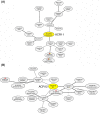The ACR11 encodes a novel type of chloroplastic ACT domain repeat protein that is coordinately expressed with GLN2 in Arabidopsis
- PMID: 21861936
- PMCID: PMC3173338
- DOI: 10.1186/1471-2229-11-118
The ACR11 encodes a novel type of chloroplastic ACT domain repeat protein that is coordinately expressed with GLN2 in Arabidopsis
Abstract
Background: The ACT domain, named after bacterial aspartate kinase, chorismate mutase and TyrA (prephenate dehydrogenase), is a regulatory domain that serves as an amino acid-binding site in feedback-regulated amino acid metabolic enzymes. We have previously identified a novel type of ACT domain-containing protein family, the ACT domain repeat (ACR) protein family, in Arabidopsis. Members of the ACR family, ACR1 to ACR8, contain four copies of the ACT domain that extend throughout the entire polypeptide. Here, we describe the identification of four novel ACT domain-containing proteins, namely ACR9 to ACR12, in Arabidopsis. The ACR9 and ACR10 proteins contain three copies of the ACT domain, whereas the ACR11 and ACR12 proteins have a putative transit peptide followed by two copies of the ACT domain. The functions of these plant ACR proteins are largely unknown.
Results: The ACR11 and ACR12 proteins are predicted to target to chloroplasts. We used protoplast transient expression assay to demonstrate that the Arabidopsis ACR11- and ACR12-green fluorescent fusion proteins are localized to the chloroplast. Analysis of an ACR11 promoter-β-glucuronidase (GUS) fusion in transgenic Arabidopsis revealed that the GUS activity was mainly detected in mature leaves and sepals. Interestingly, coexpression analysis revealed that the GLN2, which encodes a chloroplastic glutamine synthetase, has the highest mutual rank in the coexpressed gene network connected to ACR11. We used RNA gel blot analysis to confirm that the expression pattern of ACR11 is similar to that of GLN2 in various organs from 6-week-old Arabidopsis. Moreover, the expression of ACR11 and GLN2 is highly co-regulated by sucrose and light/dark treatments in 2-week-old Arabidopsis seedlings.
Conclusions: This study reports the identification of four novel ACT domain repeat proteins, ACR9 to ACR12, in Arabidopsis. The ACR11 and ACR12 proteins are localized to the chloroplast, and the expression of ACR11 and GLN2 is highly coordinated. These results suggest that the ACR11 and GLN2 genes may belong to the same functional module. The Arabidopsis ACR11 protein may function as a regulatory protein that is related to glutamine metabolism or signaling in the chloroplast.
Figures







Similar articles
-
ACR11 modulates levels of reactive oxygen species and salicylic acid-associated defense response in Arabidopsis.Sci Rep. 2018 Aug 7;8(1):11851. doi: 10.1038/s41598-018-30304-0. Sci Rep. 2018. PMID: 30087396 Free PMC article.
-
Molecular characterization of a novel gene family encoding ACT domain repeat proteins in Arabidopsis.Plant Physiol. 2002 Dec;130(4):1797-806. doi: 10.1104/pp.007484. Plant Physiol. 2002. PMID: 12481063 Free PMC article.
-
ACR11 is an Activator of Plastid-Type Glutamine Synthetase GS2 in Arabidopsis thaliana.Plant Cell Physiol. 2017 Apr 1;58(4):650-657. doi: 10.1093/pcp/pcx033. Plant Cell Physiol. 2017. PMID: 28339983
-
Arabidopsis thaliana GLN2-encoded glutamine synthetase is dual targeted to leaf mitochondria and chloroplasts.Plant Cell. 2004 Aug;16(8):2048-58. doi: 10.1105/tpc.104.022046. Epub 2004 Jul 23. Plant Cell. 2004. PMID: 15273293 Free PMC article.
-
Metabolite and light regulation of metabolism in plants: lessons from the study of a single biochemical pathway.Braz J Med Biol Res. 2001 May;34(5):567-75. doi: 10.1590/s0100-879x2001000500003. Braz J Med Biol Res. 2001. PMID: 11323742 Review.
Cited by
-
A genome-wide association study approach to the identification of candidate genes underlying agronomic traits in alfalfa (Medicago sativa L.).Plant Biotechnol J. 2020 Mar;18(3):611-613. doi: 10.1111/pbi.13251. Epub 2019 Sep 18. Plant Biotechnol J. 2020. PMID: 31487419 Free PMC article. No abstract available.
-
Stress-related expression of the chloroplast EGY3 pseudoprotease and its possible impact on chloroplasts' proteome composition.Front Plant Sci. 2022 Jul 22;13:965143. doi: 10.3389/fpls.2022.965143. eCollection 2022. Front Plant Sci. 2022. PMID: 35937369 Free PMC article.
-
Identification and characterization of ACR gene family in maize for salt stress tolerance.Front Plant Sci. 2024 Apr 30;15:1381056. doi: 10.3389/fpls.2024.1381056. eCollection 2024. Front Plant Sci. 2024. PMID: 38745920 Free PMC article.
-
The BIF Domain in Plant bHLH Proteins Is an ACT-Like Domain.Plant Cell. 2017 Aug;29(8):1800-1802. doi: 10.1105/tpc.17.00356. Epub 2017 Jul 26. Plant Cell. 2017. PMID: 28747421 Free PMC article. No abstract available.
-
Evolution and diversification of the ACT-like domain associated with plant basic helix-loop-helix transcription factors.Proc Natl Acad Sci U S A. 2023 May 9;120(19):e2219469120. doi: 10.1073/pnas.2219469120. Epub 2023 May 1. Proc Natl Acad Sci U S A. 2023. PMID: 37126718 Free PMC article.
References
Publication types
MeSH terms
Substances
LinkOut - more resources
Full Text Sources
Molecular Biology Databases
Miscellaneous

